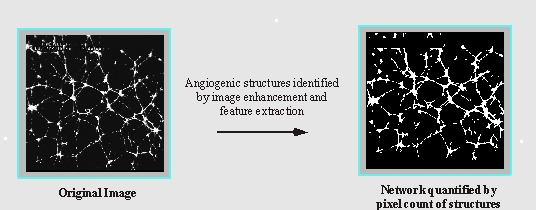Angiogenesis
The process of new blood vessel formation
The growth and development of new tissue in vivo requires adequate transport of nutrients to the tissue and removal of waste products. When new tissue is small (i.e. less than 1-2 mm diameter) local diffusion will provide sufficient mass transport to and from the site. Upon further growth, the requirements for mass transport exceed the capacity of diffusive flux, so a blood supply must be developed for the new tissue. The process of creating a stable blood source is known as angiogenesis and is mediated by many molecular entities defined as angiogenic factors.
Angiogenesis is required in tissue engineering of replacement tissues and organs to insure the new tissue has adequate blood supply for mass transport to promote adaptation and viability of the engineered tissue in the patient. For cases of undesired tissue growth in cancerous tumors and synovial pannus formation in rheumatoid arthritis, inhibition of angiogenesis is a major clinical goal. Therefore, the discovery of molecular mediators of angiogenesis and understanding the relationships between these angiogenic factors is critical to developing successful strategies to either enhance or inhibit angiogenesis.
Technology
Investigation of angiogenesis at GlycoTech involves the use of multiple in vitro and in vivo assays. The complexity of the angiogenic process suggests that no single assay is adequate to serve as a complete model of angiogenesis for the purpose of developing new and novel therapeutic strategies.
Since angiogenesis is the process of developing new blood vessels, the assays involve the formation of new vessels dominated by the migration and organization of endothelial cells. This behavior of the endothelial cells to form new tubules is monitored by visualization through a microscope for the various assay formats. Our inverted stage microscope with large working distance and equipped with bright field, phase contrast, and epifluorescent optics allows flexibility in selectition of tissue culture plates and optical mode to obtain the best visualization of cell behavior. Assays dependent on direct visualization to record results can be quite subjective by different individuals, so we utilize digital imaging to standardize and quantify the assays for determining the effect of individual agents on the angiogenic process.
GlycoTech employs four assays to investigate angiogenesis. These are: (1) Endothelial cells on matrigel, (2) Endothelial cell chemotaxis, (3) Umbilical artery outgrowth, and (4) Chick chorioallantoic membrane development.
Endothelial Cells on Matrigel
Human umbilical vein endothelial cells (huvecs) are isolated from fresh umbilical cords and used at low passage number in the assay. Huvecs are seeded on a surface coated with matrigel. The huvec cells migrate quickly and organize into a network of pre-tubules in the first 2-3 hours. A typical image of the network is seen below and is qunatified by the pixel count of the processed image.

This assay on matrigel measures both the migrational and organization of endothelial cell on a surface that facilities the initial angiogenic event. While matrigel is not required for the formation of the network structure, it greatly facilitates the process, maybe, in part due to the high degree of glycosylation of laminin which is the major component of matrigel.
Umbilical Artery Outgrowth
Arteries from fresh human umbilical cords were dissected and imbedded in a fibrin gel. Endothelial cells were observed to migrate from the ends of the arteries and in some cases organize into tubules. An angiogenic inhibitor can prevent any outgrowth into the gel. This assay is conducted for three weeks with initial outgrowth seen after 3-4 days.